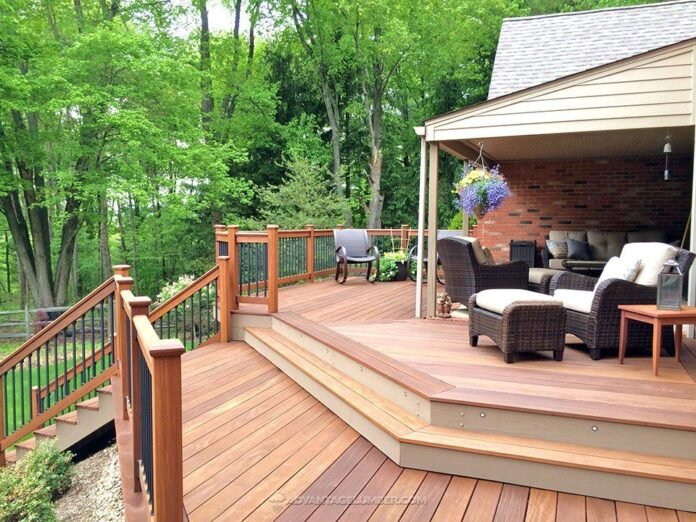You may be wondering which materials will work best in your outdoor spaces. Here are some of the most popular options: Rubber flooring, Natural stone, Slate tile, and Reclaimed wood. You can also use recycled or plant-based plastics. These materials are durable and easy to clean. If you want a greener option, consider recycled plastic or plant-based plastic tile. These materials are easy to maintain and are also great for the environment.
Natural stone
Natural stone outdoor flooring option offer a wide variety of benefits. Not only do these floors look great, but they also offer surprising functionality and broad applicability. Because natural stone contains actual minerals, it comes out clean in stone laboratories. Its many features include high compressive strength, water absorption capacity, and versatile adaptability. These attributes are rare to find in one product. Listed below are a few reasons why natural stone flooring for outdoor spaces is a good choice.
One of the greatest advantages of natural stone is that it requires minimal maintenance. Regardless of your style or decor, it will look gorgeous and last for years. Choose from slate, granite, and other stone types. Slate is particularly beautiful and comes in a variety of earth tones. Slate requires a level surface and an under layer of compacted sand or gravel. Flagstone, another natural stone option, requires a level surface and sealing after installation. Flagstone is a durable and stylish option for outdoor spaces, but can require some preparation. If you are planning on installing the floor outdoors, you will also need to remove grass before installing it. In addition, flagstone will require a sealant, making it suitable for outdoor use.
Rubber flooring
There are many advantages to rubber flooring for outdoor spaces. The material can be inexpensive and is a great way to make use of space that may otherwise be underutilized. The material is easy to install and is especially beneficial for urban settings where the surface may be uncomfortable. In addition to its durability and water resistance, rubber flooring is also easy to clean. Here are a few things to consider before deciding whether or not to use a rubber in your outdoor spaces.
Water is one of the most common causes of damage to concrete and wood deck floors. But rubber outside flooring can protect against such damage by absorbing physical shocks. The material has an exceptional coefficient of friction, making it ideal for outdoor surfaces, especially those where children or pets are allowed to play. Another advantage of rubber flooring for outdoor spaces is that the material does not harbor harmful organic byproducts. As a result, it is a great choice over concrete and wood for outdoor spaces.
Slate tile
Despite its high cost, slate is an excellent choice for outdoor floors. Unlike other types of flooring, slate is incredibly durable and suitable for outdoor settings. However, you must be careful when installing slate in outdoor spaces. While it looks great, it is not suited for a softer surface, such as sand or grass. To ensure a beautiful outdoor floor, you should consider installing a waterproof sealer before installation.
Slate tile is available in various colors and patterns and comes in a variety of shapes, styles, and materials. The higher-grade slate is used for flooring and is very durable and nonporous. Because of its anti-slip properties and resistance to stains, slate is a good choice for outdoor areas. You can also choose unshaped natural slate for walkways or paver stones. Installing slate tile is easy. It is easy to install with thin-set mortar or grout.
Reclaimed wood
There are many advantages to reclaimed wood. It is a natural material that has been harvested from old-growth trees. It has more character than wood harvested from tree farms. It can be a great flooring option if you are into eco-friendly living and want to give your outdoor space a green vibe. In addition to being an attractive material, reclaimed wood can be extremely durable and will last for many years.
Reclaimed wood comes from a variety of sources, including old barns, warehouses, and even bowling alleys. It has a unique grain pattern and hue that can add warmth to your outdoor space. It can also be used in high-traffic areas. If you want to avoid reclaimed wood, you could opt for paver or stone flooring instead. Besides that, you can customize the paver type, finish, color, and pattern of your patio with pavers.
Stamped concrete
Stamped concrete offers many advantages over other outdoor flooring options. The versatile material mimics a variety of materials and colors through molds and castings. Depending on the desired look, the patio can be custom colored or aged to match the home exterior or landscaping. Unlike other outdoor flooring options, stamped concrete has no seams and requires very little maintenance. This durable and weather-resistant material also has a protective top coat that provides traction for shoes.
Stamped concrete costs less than natural stone and can be an excellent alternative to a more expensive floor. In addition, stamping concrete can be applied over existing flooring without removing it. It is a great choice for those on a budget or looking to experiment with different styles. Unlike wood, stamping concrete is durable and can last up to 25 years if properly maintained. Stamped concrete is a practical choice for outdoor living spaces because it is inexpensive.
